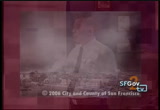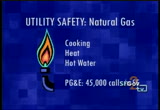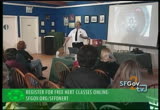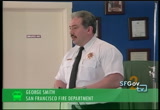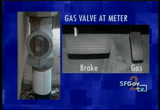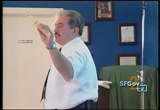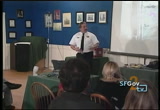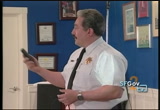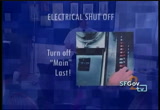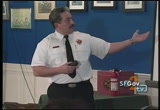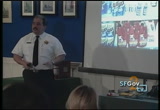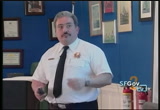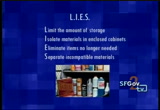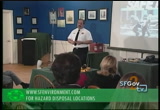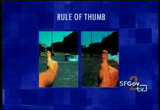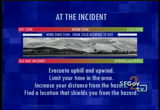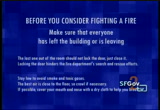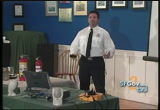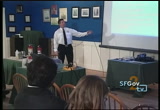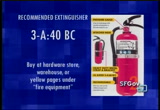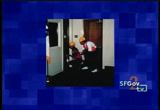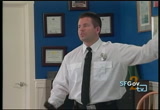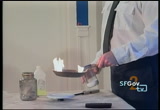tv [untitled] February 25, 2013 12:30am-1:00am PST
12:30 am
i'm rob [laughter]. >> okay. let's get into the program today is utility control and fire hazard material. we will teaching how to turn your utility's off and what hazardous materials to look for. >> the first thing is natural gas. what do you know about natural gas? flammable. it goes, boom. it's important to shut this off. we use it for cooking, eating and hot water. there were 40,000 people that called pg and e about their gas.
12:31 am
that means they call turned off their gas? did they need to do that? when do you have to? when there is a problem. how long did you think it takes pg and e to get out and turn it back on? 45,000 people. days weeks, may be a month. who has seen this in the streets. a lot of muck is in there is it's full of dirt and weeds you turn it to the right to tighten it and left to loosen it. your home work you have to look at your house, pop open the lid, look in there see what's going on in there it's not nice and clean like this. who has seen this around their house?
12:32 am
everybody. each meter has a shut off. you want to find out where your gas meter is. you can keep track of your usage but you will know how to shut it off. here's the shut off. i have some tools up here, you can look at these. any hardware store has these. they fit on this and it allows you to turn off the gas. when we talk about the wheels it's these on top. if you have a broken pipe. they will spin like mad. when it's daylight, go home, you have the heater on or the oven, look at the top wheels they are spinning got now mad. if you turn on every gas
12:33 am
appliance in our house they will move. if you break a pipe it will spin like mad. you smell gas it's dad egg smell it's methane. it rises, it's lighter than air. if you smell the natural gas you want to get out. shut off the gas and ventilate the room. get the natural gas out. to test it you want to turn it an eighth of a turn and turn it back to the way it it was. notice the little thing? that's going straight with the flow of the pipe that means it's open. if it's across that means you turned off the gas. the eighth of a turn you didn't turn it off you just moved it.
12:34 am
these are in better shape. if you can get to this valve, safely, the building's collapsed on it you can't get to it you have to use the one in the street. pg and e put all the meters outside the houses in a lot of the neighborhoods, these are pretty easy to get to. they are easy to find. if you can find the little round circle in the sidewalk. if you look directly at the house you will find this meter and this shut off on the ground floor. in is a closeup of the shut off. in is the wrench i recommend you you use it for other things. they are cheap and they will work. this is great because you can use it somewhere else if you have to. an adjustable open end wrench.
12:35 am
a diagram are off/on. shut off valve. another shut off coming out of the dirt. another problem you have a wrench that doesn't quite work. we like to leave the wrenches next to the shut off. tie is off with a wire. we will cover it again. when you shut off the gas. if the build's's collapsed good idea to shut it off there are probably pipes broken and you can have a gas leak. if you smell gas, leave the /tkaors open, don't operate electric switches that will cause a spark. don't use your cell phone. use the cell phone outside or a neighbor's phone to call 911. get everyone out of the building, close the gas valve and forget it. don't open it up again.
12:36 am
there is probably a leak and you will have troubles wait for pg and e to test it. what's the most important thing in an emergency? everyday, water. somewhere in front of the house you will see these. san francisco water department. how do you get in here? easy. a long screwdriver or pry bar. pull it this way and the whole thing will lift out. even if it's crusty you can get it out. that's what it looks like. that's brass covered water meter. there it is. how would you tell if water was leaking if the building without going in there? that thing woulding pegged. this guy would be spinning. here's how you shut it on and off.
12:37 am
like the gas thing, the valve thing with the square head. there are a couple of ears. you lineup the 2 ears. there is a hole to put a padlock. if it's on ita in direction of the /phroe. flow. when it's off, these 2 lineup. the 2 ears will lineup so you can put a padlock in there. that tells you you hava shut off. like that gas circle thing, if you see that thing in a sidewalk and you are standing in the street and you have that in front of you and look directly at the house you will find the gas shut off. same with the water. if you have the water thing in front of you and look directly at the house. 9 times out of 10 on the floor you will find the main water
12:38 am
shut off, here. a lot of places have the sprinklers if you shut off the main in the street you shut off the fire systems. so, if you have a choice of shutting off the water in somebody's house go for the one that coming between the foundation, usually it's in the garage or basement. you turn it to the right. right to tighten, left to loosen. this is easier to turn on and off if you is get in the garage. if you can't use the one in the street. do it only if it's say safe to do so. if it's dangerous, leave it. >> this is a basic electric system. a switch and the screw in fuses. there are not many of these anymore.
12:39 am
most have the breakers. okay. to show you what they look like. on, off. this is a safety box you can't get it open until you turn it off. a couple of screw in fuses. this is a cartridge and screw in fuses. here it says on and off. pull it out stick it upside down and stick it back in. circuit break /-rs this is what most have. you have the meter. that's how pg and e /khrarpblgs us. you have the big main. usually there are 60 or a hundred or 50. the little guys are 20-15-30. if you want to shut off the power you shut off the little guys first than the main. when you throw a switch there
12:40 am
is the arch. like water when water flows in an old house any you shut it off quick you get the hammer effect? that's like electricity. is it safe to do it if you smell natural gas? show of hands. >> nobody has their hands up. it's not safe to flicking any switches if you smell natural gas. how about if there is smoke coming out of an outlet. if you shut this off in an area where there is no gas, good idea. >> just about anything can be a hazardous material, cleaners,
12:41 am
solvants, hair products anything can be hazardous. they are every where. the only time they are hazardous if they are misused our there is a disaster. do you see these in san francisco? that's probably propane. we have a port. in an industrial area. it identified where they are stored. are there hazardous storage places in this air? no. are there a dry cleaners? yes. who remembers grand auto. they have solvants, cleaners, octane boosters. it's great until there is a natural disaster. where does this end up? on the floor. it gets mixed together and
12:42 am
becomes a hazardous soup and it's usually slippery. safeway, what do you think they have in there, kids? we will show you. bleach. okay. bleach is great i used it this afternoon to get my shirt white it's great. do we need this much bleach at home? no. safeway need it? probably not. look what they have across from the bleach. it says don't mix ammonia and bleach makes a gas. these are bad things to mix with bleach. who's got these under their sink in i do. everybody does. you want to separate the ones that don't go to together. how do you find out? read the labels. these are department of transportation placards, they
12:43 am
are colored. they are all red. they have the sort of flame thing up there. the little number here and number here. we've got books in our rig that tell us what these are. based on a number. we will see a 1219, look in the book and say a truck carrying 1219 and it's leaking every where what do we have. george, we have 92 octane gasoline, that's not good. we call people and get help. we as volunteers are not going to be hazardous material people. you need to know this is red, it's flammable. if there is a problem, let us know and keep people away from it. these are more placards.
12:44 am
explosives, anything orange, reds yellow. oxidizer, that's going to make a small fire into a really big fire without much help. inhalation hazards, don't breathe it. okay. the rest it self explanatory. there is nfpa 704 diamonds, you don't need to know that blue, health. :number 4 it will wreck your health fast. 0 means no problem. red, same. 4 means it's a fire hazard and poof, catch on fire like that. this is it may detonate. this is the dns hacienda.
12:45 am
there is a health hazard but we are clueing into number 4. there is flammable stuff in there when frank and i show up we put on our thinking caps. >> do you think putting this great label on the front door is a good idea? glass front door? may be not. what happens when you leave you leave the door open or when we show up, we break the door down. somewhere to the side is better. hazardous material and how they get into us. you breathe them. you can eat them or get them on you. okay. or they can be injected into you. like if you have hazardous material at the grand autoand
12:46 am
you slip and you get stuck. it's in you and on you. stay out of that place. here's a look of hazardous spills. the can tainer is bubling and oozing. bubling liquids or vapors. yeah. anything like that if you see something like that after an earthquake. don't kick it, pick it up or taste it. you will safety first. then everybody around you. isolate the area, for everybody else. and notice the fire department, that's us. around the house we use, limit the amount of stuff you are storing. we like to isolate the materials in enclosed cabinets
12:47 am
locked metal ones are best, separate the flammables for the oxidizers. the bleach from the ammonia. you will ask me, george, where do i take this garage full of stuff. i have a garage full of stuff i don't use. there is a place on tunnel avenue if you are a city resident you take it down there and show them you are a city resident and they will take it. call us. say, i can't get down there i have, they might come out with 50 gallon drums if you have waste or oil they will come and pick it up. if you have gasoline you haven't used in a while they will come and pick it up. the main thing is safety. we don't want to end up like
12:48 am
this guy. he didn't heed the warnings. for each one of these to carry out this guy, how many guys are backing them up? i figure 4 a piece. we don't send in a team unless we have the same amount of people and then some to back them up. to get you to gage what an incident is the guy with the big thumb. the rule of thumb is this. if you cover the incident with your thumb you are far enough away. does it look like he's got it covered with his thumb? you see the smoke going to the side. he's still too close. he's got to back up further even with the rule of thumb. we want you to view the rule of
12:49 am
time, distance and shielding. what's time, don't stick around. distance. get far away. shielding means put something solid in between you and the incident. >> you want to get uphill and up wind. you don't want to be down here, have the /weupbtd behind you. where does the wind come from in san francisco. the right place is on the beach between twin peek and it is incident. unless the incident was at the beach. here's the i incident you want to be here. up wind, uphill . anybody ever put a fire out
12:50 am
before by yourself. small fire. >> that's the good kind you want to stop it when it's small. george and i and the fire department will take care of the big fires but think if everybody in the room had a fire extinguishers how many fires you could put out. this is a big fire we will get these. it's hard for us to get around in a disaster from the streetcars and trolley buses stop, no electricity. we have the above groundwater system. it was invented years ago by our fire chiefs this is what saved the marina the boat pumping the water out put the fires out in the marina. you want to stop, look, listen and think. you size up the situation this
12:51 am
is what we do in the fire department. you look at it. is it a little fire. a candle burning. do i get the fire extinguisher. is it a big fire can i put it out. >> it would cover the area the size of a table. anything bigger or high are than your head it's too big for you to put out with an extinguisher. wait until everybody is out. it's best to work in pairs. make sure you are the last one out of the room. do not lock it. avoid smoke and gases. cover your mouth and nose with a towel or sheet or dry cloth.
12:52 am
if you have a jacket, if there is a flame on the way out put clothes on or wrap yourself in a blanket the layer of clothing will give you protection. have an emergency plan for earthquakes and fires. elevators, a safe place to be? always take it is stairs. when you go down the stairs hang on to the hand rails you will have people bump into you. pay attention to the floors, you have fourth floor, third floor, in case the lights go out you know you have 3 more floors. people think, i will go to the bottom until it stops. let's say you have 2 floors of
12:53 am
parking you are under ground. sometimes it's a fire escape, never go up unless there is smoke down there and you can't go down. majority of the time don't go up. it's not like in tower interno where you go to the roof and the helicopters come pick you up u. notice fire department, work in pairs with 2 extinguishers. one extinguisher and the other person is a backup to get you out. that's an nert volunteer. never fight a fire if it's a large fire. large is over your head. if you are scared and it's too big, it's too large for you. if it's spread beyond where it started and blocking our escape route and you are unsure how to use an extinguisher. there are 4 types of fire it's
12:54 am
on the label. on the front. down here. water type extinguisher it's a chrome big thing that holds 2-1/2 gallons of water. 30-40 feet away is the maximum, you want to get closer. flood it with water you can put your thumb over the tip and it fans it out. dry chemicals, inside here this is a bc this is one you might have in your car. it's not used on wood, paper, classic fires only on flammable liquid and electrical fires that's what you use in your car. if will have a pressure gauge. metal handle and it will have a good sized rubber nozzle and the label and all that will tell you the fire it's for.
12:55 am
pass, pull the pin out. aim the nozzle. squeeze the lever. don't squeeze it and class 6 this happens. don't shoot the instructor in the foot because when you hold it, hold it here and don't squeeze down when you pull the pin and squeeze it will shoot down. keep your thumb out of the way and aim at the base of the fire. you sweep slowly back and forth and move in closer. don't be afraid. the closer you get the more dry chemical powder you will put on the fire and it will go out faster. stay low. before you enter a room feel the door with the back of your hand. if it's hot and you don't see smoke, open it slowly, take a
12:56 am
look inside, you know if it's a small fire and you can put it out, do it. work in pairs. the second person is your back up. if the fire is too big, close the door and get help. have 2 emergency exits if you can. there is a fire escape there and the stairway we came up, there's your 2 exists. you seen these before? the hose cabinets. there is a fire extinguisher in there, 50 feet of hose. a nozzle and water in there you can turn it on. don't do what he's doing. if you turn this on you will have a pile of spaghetti with hose. one person take the hose out to where you are going to put the fire out. tonight open the door, yet and have the other person turn the
12:57 am
water on. if you don't feel comfortable, get out. keep yourself safe. we have gauze. this is made of cotton. what class of fire is that? a. >> we have some fire. we have air. we have heat. we have a fire going. if i went in like that what did i just do? >> smoth erred it. simple; right . remember the hot water heater, we say don't store gasoline in your garage? so, gasoline gives out vapors, if we heat this up. not that you have to heat the gasoline. if you store gasoline near a hot water heater the vapors alone will catch fire.
12:58 am
the vapors travel and caught. you don't have to actually light something like a candle, you don't actually have to touch something. we will add, more, make more effect, here. you got cherries jubilee. how do you put this out? [laughter]. put the lid? what if you don't have a lid? cookie sheet. >> very good. that's a good one. cover the thing, take it off the burner. take it off. do i immediately open it again? no. you already put it out leave it alone and whether or not it is the cheapest fire extinguisher
12:59 am
you can buy? baking soda. have a couple boxes of baking soda, near the stove. cut the top off so it's ready to go. you get the box and, boom, dump it on there. you don't stir is around. you smoth erred it, baking soda doesn't burn. now, we are down to the home work. read these pages in your book, 26-38. locate the gas, water, electric shut off inside and outside the home. do the course evaluation. crank the gas an eighth of a turn to make sure it works and you know where it's at. very good. thank you. [applause].
53 Views
IN COLLECTIONS
SFGTV2: San Francisco Government Television Television Archive
Television Archive  Television Archive News Search Service
Television Archive News Search Service 
Uploaded by TV Archive on

 Live Music Archive
Live Music Archive Librivox Free Audio
Librivox Free Audio Metropolitan Museum
Metropolitan Museum Cleveland Museum of Art
Cleveland Museum of Art Internet Arcade
Internet Arcade Console Living Room
Console Living Room Books to Borrow
Books to Borrow Open Library
Open Library TV News
TV News Understanding 9/11
Understanding 9/11